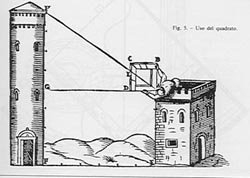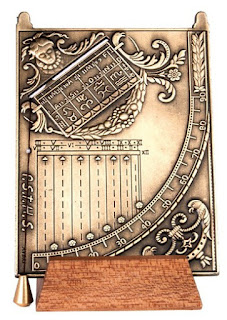STEP #09 - Gli inventori
One of the earliest accounts of a quadrant comes from Ptolemy's Almagest around AD 150. He described a "plinth" that could measure the altitude of the noon sun by projecting the shadow of a peg on a graduated arc of 90 degrees. This quadrant was unlike later versions of the instrument; it was larger and consisted of several moving parts. Ptolemy's version was a derivative of the astrolabe and the purpose of this rudimentary device was to measure the meridian angle of the sun.
Islamic astronomers in the Middle Ages improved upon these ideas and constructed quadrants throughout the Middle East, in observatories such as Marageh, Rey and Samarkand. At first these quadrants were usually very large and stationary, and could be rotated to any bearing to give both the altitude and azimuth for any celestial body. As Islamic astronomers made advancements in astronomical theory and observational accuracy they are credited with developing four different types of quadrants during the Middle Ages and beyond. The first of these, the sine quadrant, was invented by Muhammad ibn Musa al-Khwarizmi in the 9th century at the House of Wisdom in Baghdad. The other types were the universal quadrant, the horary quadrant and the astrolabe quadrant.
During the Middle Ages the knowledge of these instruments spread to Europe. In the 13th century Jewish astronomer Jacob ben Machir ibn Tibbon was crucial in further developing the quadrant. He was a skilled astronomer and wrote several volumes on the topic, including an influential book detailing how to build and use an improved version of the quadrant. The quadrant that he invented came to be known as the novus quadrans, or new quadrant. This device was revolutionary because it was the first quadrant to be built that did not involve several moving parts and thus could be much smaller and more portable.
As the quadrant became smaller and thus more portable, its value for navigation was soon realized. The first documented use of the quadrant to navigate at sea is in 1461, by Diogo Gomes. Sailors began by measuring the height of Polaris to ascertain their latitude. This application of quadrants is generally attributed to Arab sailors who traded along the east coast of Africa and often travelled out of sight of land. It soon became more common to take the height of the sun at a given time due to the fact that Polaris disappears south of the equator.


Commenti
Posta un commento